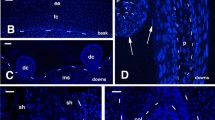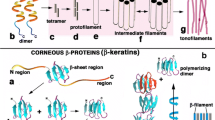Abstract
During most of feather growth (anagen), the dermal papilla stimulates the collar epithelium to give rise to feather keratins accumulating cells that form most of the corneous material of barbs and the rachis. Aside from the induction of differentiated cells of the feather, the distal part of the papilla forms a loose connective tissue that nourishes the growing feather, termed the pulp. In the last stages of feather growth, the pulp undergoes a process of re-absorption and leaves empty cavities indicated as pulp cups surrounded by keratinized cells inside the calamus. The process of cornification of pulp cups in different species of birds has been described here by using electron microscopy and immunocytochemistry for keratins. Pulp cells accumulate bundles of soft (alpha)-keratin, but do not synthesise feather keratins as in the surrounding calamus cells. Cells of the pulp epithelium accumulate large amounts of lipids and form a softer keratinized epithelium surrounding the pulp. This type of keratinization resembles the formation of soft epidermis in apteric and interfollicular regions. The role of the cornified pulp epithelium is to limit water loss and to form a microbe barrier before the mature feather is moulted.








Similar content being viewed by others
References
Alibardi L (2002) Keratinization and lipogenesis in epidermal derivatives of the zebrafinch, Taeniopygia guttata castanotis (Aves, Passeriformes, Ploecidae) during embryonic development. J Morphol 251:294–308
Alibardi L (2005) Cell structure of developing barbs and barbules in downfeathers of the chick: central role of barb ridge morphogenesis for the evolution of feathers. J Submicrosc Cytol Pathol 37:19–41
Alibardi L (2006) Cells of embryonic and regenerating germinal layers within barb ridges: implication for the development, evolution and diversification of feathers. J Submicrosc Cytol Pathol 38:51–76
Alibardi L (2007a) Cell organization of barb ridges in regenerating feathers of the quail: implications of the elongation of barb ridges for the evolution and diversification of feathers. Acta Zool 88:101–117
Alibardi L (2007b) Keratinization of sheath and calamus cells in developing and regenerating feathers. Ann Anat 189:583–595
Alibardi L (2007c) Cell interactions in barb ridges of developing chick downfeather and the origin of feather branching. Ital J Zool 74:143–155
Alibardi L, Sawyer RH (2006) Cell structure of developing downfeathers in the zebrafinch with emphasis on barb ridge morphogenesis. J Anat 208:621–642
Alibardi L, Toni M (2008) Cytochemical and molecular characteristics of the process of cornification during feather morphogenesis. Prog Histochem Cytochem 43:1–72
Brush AH (1993) The origin of feathers: a novel approach. In: Farner D, King JA, Parker KC (eds) Avian Biol. IX. Academic Press, New York, pp 121–162
Chuong CM, Edelman GM (1985a) Expression of cell-adhesion molecules in embryonic induction. I. Morphogenesis of nestling feathers. J Cell Biol 101:1009–1026
Chuong CM, Edelman GM (1985b) Expression of cell-adhesion molecules in embryonic induction. II. Morphogenesis of adult feathers. J Cell Biol 101:1027–1043
Chuong CM, Widelitz RB (1999) Feather morphogenesis: a model of the formation of epithelial appendages. In: Chuong CM (ed) Molecular basis of epithelial appendage morphogenesis. Landes Bioscience, Georgtown, pp 57–73
Chuong CM, Wu P, Zhang FC, Xu X, Yu M, Widelitz RB, Jiang TX, Hou L (2003) Adaptation to the sky: defining the feather with integument fossils from mesozoic china and experimental evidence from molecular laboratories. J Exp Zool 298B:42–56
Gregg K, Rogers GE (1986) Feather keratin: composition, structure and biogenesis. In: Bereiter-Hahn J, Matoltsy AG, Sylvia-Richards K (eds) Biology of the integument, vol 2, Vertebrates. Springer, Berlin, pp 666–694
Lillie FR (1943) On the development of feathers. Biol Rev 17:247–266
Lucas AM, Stettenheim PR (1972) Growth of follicles and feathers. Color of feathers and integument. In “Avian anatomy. Integument”. Agriculture Handbook, vol 362. Chap. 7, US Department of Agriculture, Washington DC, pp 341–419
Maderson PFA, Alibardi L (2000) The development of the sauropsid integument: a contribution to the problem of the origin and evolution of feathers. Am Zool 40:513–529
Matulionis DH (1970) Morphology of the developing down feathers of chick embryos. A descriptive study at the ultrastructural level of differentiation and keratinization. Z Anat Entw Gesch 132:107–157
Menon GK, Menon J (2000) Avian epidermal lipids: functional considerations in relation to feathering. Am Zool 40:540–542
Prum RO (1999) Development and evolutionary origin of feathers. J Exp Zool 285:291–306
Prum RO, Williamson S (2001) Theory of the growth and evolution of feather shape. J Exp Zool 291:30–57
Rawles ME (1960) The integumentary system. In: Marshall AJ (ed) Biology and comparative physiology of birds, vol 1. Academic Press, New York & London, pp 189–240
Sawyer RH, Knapp LW (2003) Avian skin development and the evolutionary origin of feathers. J Exp Zool 298B:57–72
Sawyer RH, Glenn T, French JO, Mays B, Shames RB, Barnes GL, Rhodes W, Ishikawa Y (2000) The expression of beta (β) keratins in the epidermal appendages of reptiles and birds. Am Zool 40:530–539
Scala C, Cenacchi G, Ferrari C, Pasquinelli G, Preda P, Manara G (1992) A new acrylic resin formulation: a useful tool for histological, ultrastructural, and immunocytochemical investigation. J Histochem Cytochem 40:1799–1804
Spearmann RIC, Hardy JA (1985) Integument. In: King AS, McLelland J (eds) Form and function of birds, vol 3. Academic Press, London, pp 1–56
Yu M, Yue Z, Wu P, WU DY, Mayer JA, Medina M, Widelitz RB, Jiang TX, Chuong CM (2004) The developmental biology of feather follicle. Int J Dev Biol 48:181–191
Yue Z, Jiang TX, Widelitz RB, Chuong CM (2005) Mapping stem cell activities in the feather follicle. Nature 438:1026–1029
Acknowledgments
The study was partially supported by a 60% grant from the University of Bologna and largely by self-support. Dr. Mattia Toni’s skill with the Corel Draw 11 program in computer-generated figures is greatly appreciated.
Author information
Authors and Affiliations
Corresponding author
Rights and permissions
About this article
Cite this article
Alibardi, L. Cornification of the pulp epithelium and formation of pulp cups in downfeathers and regenerating feathers. Anat Sci Int 84, 269–279 (2009). https://doi.org/10.1007/s12565-009-0033-2
Received:
Accepted:
Published:
Issue Date:
DOI: https://doi.org/10.1007/s12565-009-0033-2




